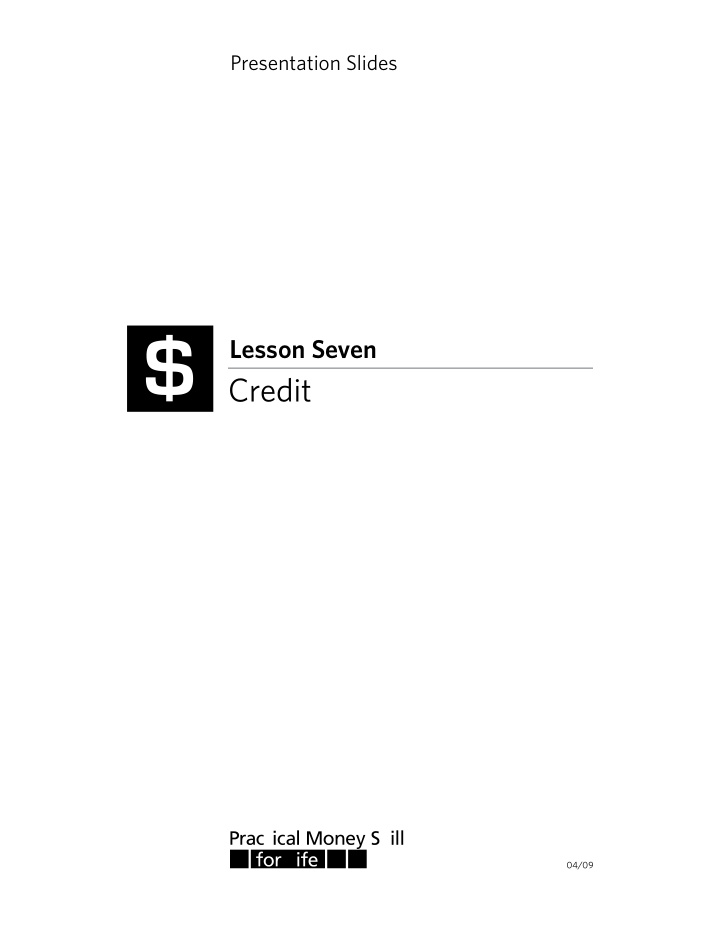



Presentation Slides $ Lesson Seven Credit 04/09
advantages and disadvantages of using credit advantages: ■ Able to buy needed items now ■ Don’t have to carry cash ■ Creates a record of purchases ■ More convenient than writing checks ■ Consolidates bills into one payment disadvantages: ■ Interest (higher cost of items) ■ May require additional fees ■ Financial difficulties may arise if one loses track of how much has been spent each month ■ Increased impulse buying may occur slide 7-A www.practicalmoneyskills.com credit
the three Cs character—will you repay the debt? From your credit history, does it look like you possess the honesty and reliability to pay credit debts? ■ Have you used credit before? Do you pay your bills on time? ■ Do you have a good credit report? ■ Can you provide character references? ■ How long have you lived at your present address? ■ How long have you been at your present job? ■ capital—what if you don’t repay the debt? Do you have any valuable assets such as real estate, savings, or investments that could be used to repay credit debts if income is unavailable? What property do you own that can secure the loan? ■ Do you have a savings account? ■ Do you have investments to use as collateral? ■ capacity—can you repay the debt? Have you been working regularly in an occupation that is likely to provide enough income to support your credit use? Do you have a steady job? What is your salary? ■ How many other loan payments do you have? ■ What are your current living expenses? What are your current debts? ■ How many dependents do you have? ■ slide 7-B www.practicalmoneyskills.com credit
your responsibilities Borrow only what you can repay. ■ Read and understand the credit contract. ■ Pay debts promptly. ■ Notify creditor if you cannot meet payments. ■ Report lost or stolen credit cards promptly. ■ Never give your card number over the phone unless you initiated the call or are certain of the ■ caller’s identity. slide 7-C www.practicalmoneyskills.com credit
your rights truth in lending act (1968) Ensures consumers are fully informed about cost and conditions of borrowing. fair credit reporting act (1970) Protects the privacy and accuracy of information in a credit check. equal opportunity act (1974) Prohibits discrimination in giving credit on the basis of sex, race, color, religion, national origin, marital status, age, or receipt of public assistance. fair credit billing act (1974) Sets up a procedure for the quick correction of mistakes that appear on consumer credit accounts. fair debt collection practices act (1977) Prevents abuse by professional debt collectors, and applies to anyone employed to collect debts owed to others; does not apply to banks or other businesses collecting their own accounts. slide 7-D www.practicalmoneyskills.com credit
building a credit history ■ Establish a steady work record. ■ Pay all bills promptly. ■ Open a checking account and don’t bounce checks. ■ Open a savings account and make regular deposits. ■ Apply for a local store credit card and make regular monthly payments. ■ Apply for a small loan using your savings account as collateral. ■ Get a co-signer on a loan and pay back the loan as agreed. slide 7-E www.practicalmoneyskills.com credit
a credit report slide 7-F www.practicalmoneyskills.com credit
manner of payment codes status type of account code O Open (entire balance due each month) R Revolving (payment amount variable) I Installment (fixed number of payments) status timeliness of payment 0 Approved not used; too new to rate 1 Paid as agreed 2 30+ days past due 3 60+ days past due 4 90+ days past due 5 Pays or paid 120+ days past the due date; or collection account 6 Making regular payments under wage earner plan or similar arrangement 7 Repossession 8 Charged off to bad debt slide 7-G www.practicalmoneyskills.com credit
types and sources of credit single-payment credit Items and services are paid for in a single payment, within a given time period, after the purchase. Interest is usually not charged. ■ Utility companies, medical services Some retail businesses ■ installment credit Merchandise and services are paid for in two or more regularly scheduled payments of a set amount. Interest is included. Some retail businesses, such as car and appliance dealers ■ Money may also be loaned for a special purpose, with the consumer agreeing to repay the debt in two or more regularly scheduled payments. Commercial banks ■ Consumer finance companies ■ Savings and loans ■ Credit unions ■ revolving credit Many items can be bought using this plan as long as the total amount does not go over the credit user’s assigned dollar limit. Repayment is made at regular time intervals for any amount at or above the minimum required amount. Interest is charged on the remaining balance. Retail stores ■ Financial institutions that issue credit cards ■ slide 7-H www.practicalmoneyskills.com credit
how much can you afford? (the 20-10 rule) never borrow more than 20% of your yearly net income ■ If you earn $400 a month after taxes, then your net income in one year is: 12 x $400 = $4,800 ■ Calculate 20% of your annual net income to find your safe debt load. $4,800 x 20% = $960 ■ So, you should never have more than $960 of debt outstanding. ■ Note: Housing debt (i.e., mortgage payments) should not be counted as part of the 20%, but other debt should be included, such as car loans, student loans and credit cards. monthly payments shouldn’t exceed 10% of your monthly net income ■ If your take-home pay is $400 a month: $400 x 10% = $40 Your total monthly debt payments shouldn’t total more than $40 per month. ■ Note: Housing payments (i.e., mortgage payments) should not be counted as part of the 10%, but other debt should be included, such as car loans, student loans and credit cards. slide 7-I www.practicalmoneyskills.com credit
Recommend
More recommend